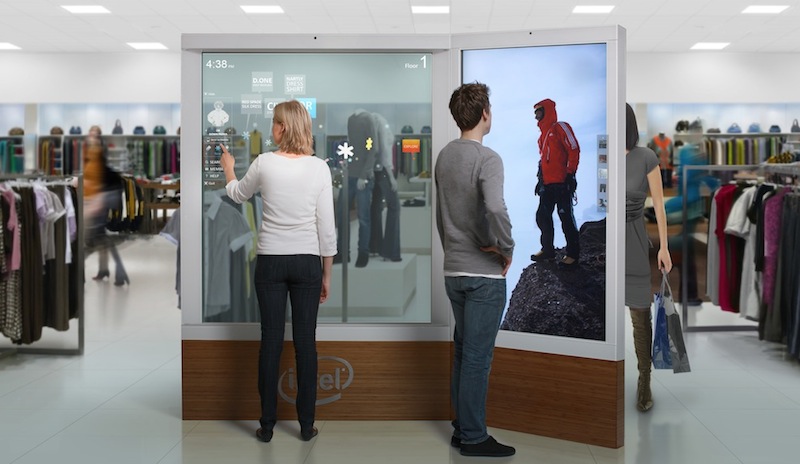Intel Inc.: Digital Signage Proof of Concept II
«Devices are becoming connected, and once they become connected, they want to be intelligent.»
First revealed at the International Consumer Electronics Show in Las Vegas January 2010, Intel’s Digital Signage demonstration emulates a virtual brick-and-mortar store setting where customers may use the 7-foot-6-inch multi-user, multi-touch holographic screen to explore merchandise, find out about promotions, submit feedback on products, read customer reviews, view past purchasing histories and share what they have discovered with their friends via social media and mobile phone integration.
For more details see: https://blog.hslu.ch/outofhomedisplays/2010/03/20/intel-digital-signage-proof-of-concept/).
Here’s the interview with Intel’s head of digital signage development, Jose Avalos, just after his conference session at ISE Amsterdam, published in SmartReport No. 10 issue:
Please give us a synopsis of your presentation at ISE…
In summary, we are seeing a huge revolution in embedded segments, and it comes down to the fact that the devices are becoming connected, and once they become connected, they want to be intelligent. One of the segments we are focusing on, because we see tremendous growth, is Digital Signage. We have increased our investment in Digital Signage and it’s a strategic segment for us, for the embedded group at Intel.
At Intel, we have developed a portfolio of products that spans from basic digital signage with our Atom processor to mainstream with our i5 Core Processor right through to high end video wall applications with our i7 processor.
Intel has developed a number of technologies that have a high affinity for digital signage, because they really solve some of the issues we have in the industry, and also solve some key issues for the end user. For example, our Active Management Technology that sits below the OS, allows you to remotely manage signs and drive energy efficiency in networks. The performance of our Core platforms allow you to deliver a rich media content experience to the end user, and allows you to use anonymous video analytics for advertising metrics.
How is Intel “pushing” these ideas forward in the market?
Intel is driving a number of initiatives in the industry to help it grow. For example, just recently at the National Retail Federation trade show in New York, we launched our Digital Signage proof of concept, which is designed to motivate the industry with usage models that we think are going to be mainstream in three to five years, but using today’s technology… using the computing elements that our customers will use this year to develop their products.
We also announced a strategic relationship with Microsoft where we communicated to the industry that we are going to be introducing a platform that is pre-validated by Intel and Microsoft, based on our Core processors and on the Windows Embedded Standard 7, and this platform would be jointly developed and validated by Intel and Microsoft. We hope to address some of the fragmentation in the marketplace with this platform.
As you say, you’ve seen the Digital Signage market as a great opportunity at Intel, so do you think the teaming with Microsoft is going to cause a kind of “wave” effect?
Well we’re seeing a tremendous response. When we launched the platform at the NRF conference, we had seven of our customers there demonstrating either proof of concepts or demos using that platform. I know of at least a few that will be announcing new product based on this platform in the Q2 timeframe this year. We believe it’s going to be very successful. The feedback we’re getting from customers is that this will be the next generation mainstream platform for the industry.
How important will such things as anonymous video analytics be for the future of the industry
One important thing with anonymous video analytics is that you have to respect the privacy of the end user, so we don’t collect any private information about the end user. We just collect data about gender, about how many eyeballs are looking at the sign and for how long. The reason this is important is because this technology provides the foundation for proof of play and proof of impression, which is the data that the advertising companies need to demonstrate their ROI to the brands.
Has Intel been talking to the agencies about what they need? How have you brought together ideas in that respect?
We do have an internal programme where we have interviewed 14 different agencies to try to understand their needs and to try to understand the industry needs, so that we can tailor our technology solutions to meet their needs.
Source: SmartReport Digital Out of Home, No. 10 (october 2010 – january 2011), p. 20/21 (pdf, 6.25MB)
